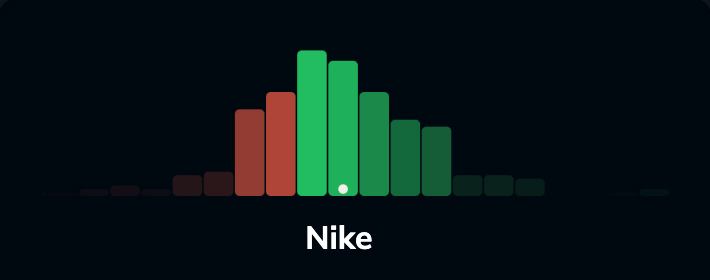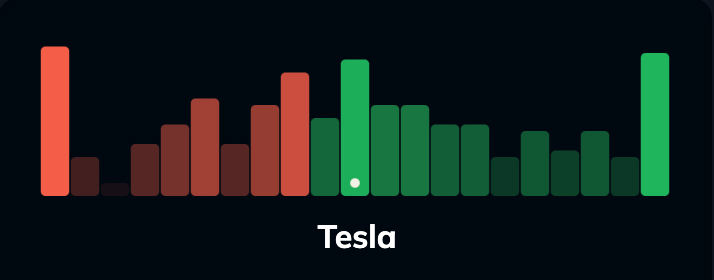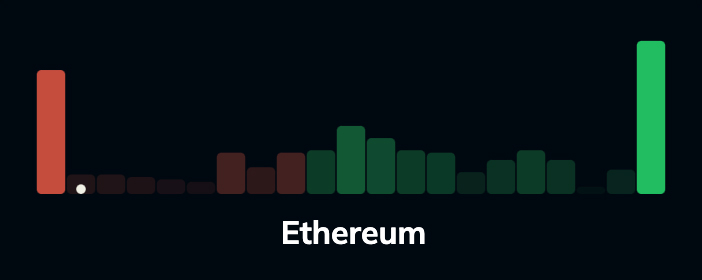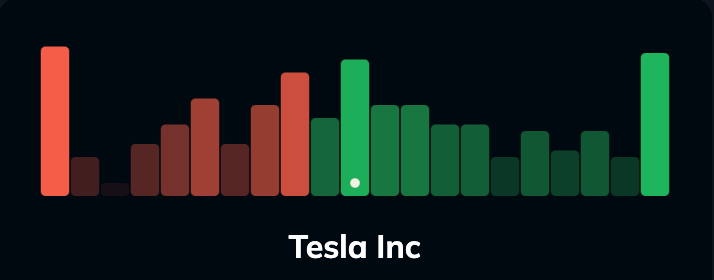We clearly hit a nerve with our extended piece on histograms and the shape of risk in the last RISK Rituals newsletter. Moreover, many of you visited our new Shape of Risk landing page to see for yourself what all the buzz is about. That’s great!
Well, we’re just getting started, and you’re about to get an interactive glimpse of how powerful these histograms are. Let’s start by taking a look at a few different histograms now.
Nike has a more “normal” looking histogram. I especially like how the green section (positive daily gains) is much bigger than the red section (negative daily gains). Nike has had a good year.

Tesla has some fat tails going on. Frankly, they’re a little too fat for a company with a market cap of $700 billion. Musk is a little too loose with the memes for my personal tastes, but I have to admit, the guy backs up his talk with some serious walk.

For a more extreme example of a fat-tailed histogram, let’s look at Ethereum. It’s not as extreme as GameStop, AMC, or Dogecoin but it does have some serious polarization going on.

By the way, the little white dot on each histogram is where the prior day’s gain fell in the current histogram.
When I look at these histograms, I’m looking to see how I’m affected psychologically by these price patterns. I’m likely sleeping like a baby if I own Nike. I’m going to be a bit restless if I own Tesla, and I’m going to be downright nauseous if I own (too much) Ethereum.
The beauty of investing, however, is that you don’t have to (and you shouldn’t) own just one asset. You should own a portfolio of assets. Ray Dalio famously described a holy grail portfolio as “15 to 20 good, uncorrelated return streams.” I couldn’t agree more.
So, let’s see what we get when we combine Nike, Tesla, and Ethereum into a three-asset portfolio. Let’s say we want to invest $10,000 in a portfolio of these three assets.
A simple way to do that would be to put $3,333.33 into each asset. If we do that, our one-year portfolio histogram looks like this:

Definitely still some fat tails and a bit erratic in the middle. I’d say that’s still a little wild for my personal tastes.
Here’s another way to create a portfolio of these three stocks. This is something that I first pioneered nearly a decade ago. It’s called volatility weighting. We put the most money into the least volatile asset and the least money into the most volatile asset. This approach helps us invest in something wilder – like Ethereum – and still sleep at night.
Using this approach to spread our $10,000 across this portfolio of three stocks, we would have invested $5,868 in Nike, $2,567 in Tesla and $1,565 in Ethereum. That would have produced a one-year histogram that looks like this:

Now we’re starting to get to something that I think I could live with. It’s pretty “normal” looking in the middle, but it’s also got a little edginess, which, I must admit, does have some appeal for me.
Here’s the thing – each of us must gradually figure out what “shape of risk” works for us individually. There’s no one-size-fits-all answer to how much volatility each person can effectively manage in their own portfolio. Remember, successful investing does require a commitment to self-awareness and even mindfulness. Investor, know thyself.
There are two parts to great risk management. One is knowing how much risk you can take. That’s your risk budget. The other is making sure that once you know your risk budget, you can spend it effectively. You’ve got to maximize the reward that you earn for the risk you can take.
I’ve got great news for you. We’ve enhanced our Shape of Risk landing page so that you can play around and combine assets to build your own custom portfolio. You can even try our volatility weighting algorithm. It’s super cool. I really think you’re going to love it.
Bottom line, today we are building tools to give you the feedback and analytics you need to both build a great portfolio and gradually discover your own optimal program of risk and reward.
One last thing before we conclude this issue. I do believe that in today’s media-driven world (both social and cable media), we have to be particularly careful when putting our capital (both money and attention) into these highly polarized price patterns, like we see in GameStop, AMC, Dogecoin and, yes, in Ethereum.
Extreme volatility and polarization alone are not necessarily bad things. Anytime new investment opportunities arise around new technology, we are going to get volatility.
But in today’s world, there is no doubt that these patterns of polarization are also being weaponized to ensure that we stay glued to our screens and never leave the casino table.
More on that next time. For now, be sure to check out our new portfolio histogram builder at the Shape of Risk landing page and start exploring how to make risk your friend instead of your foe.

